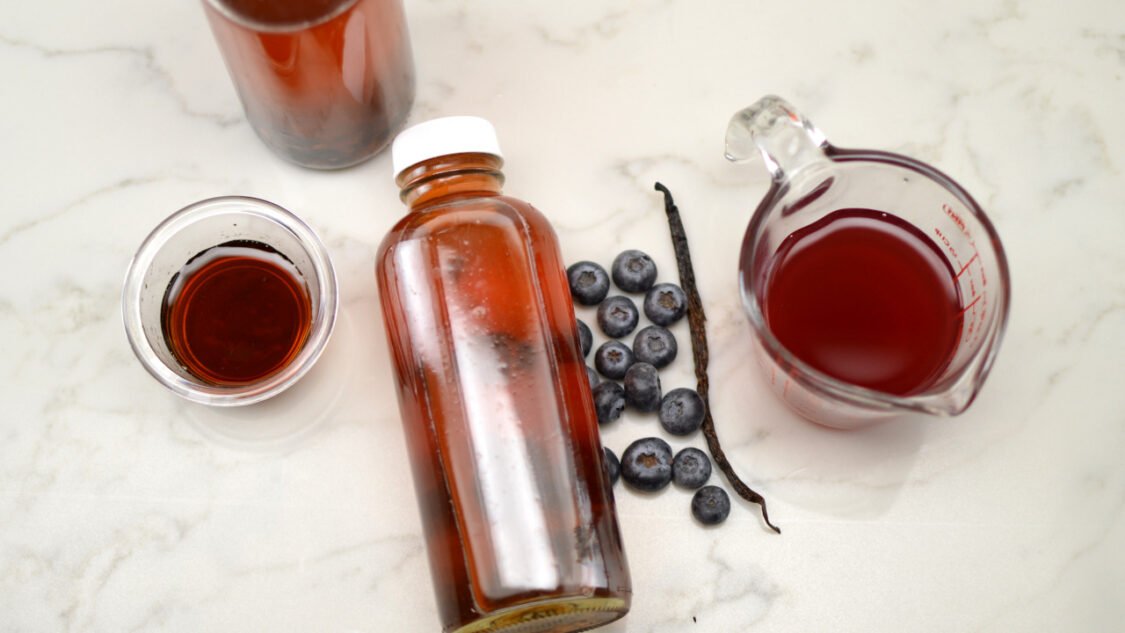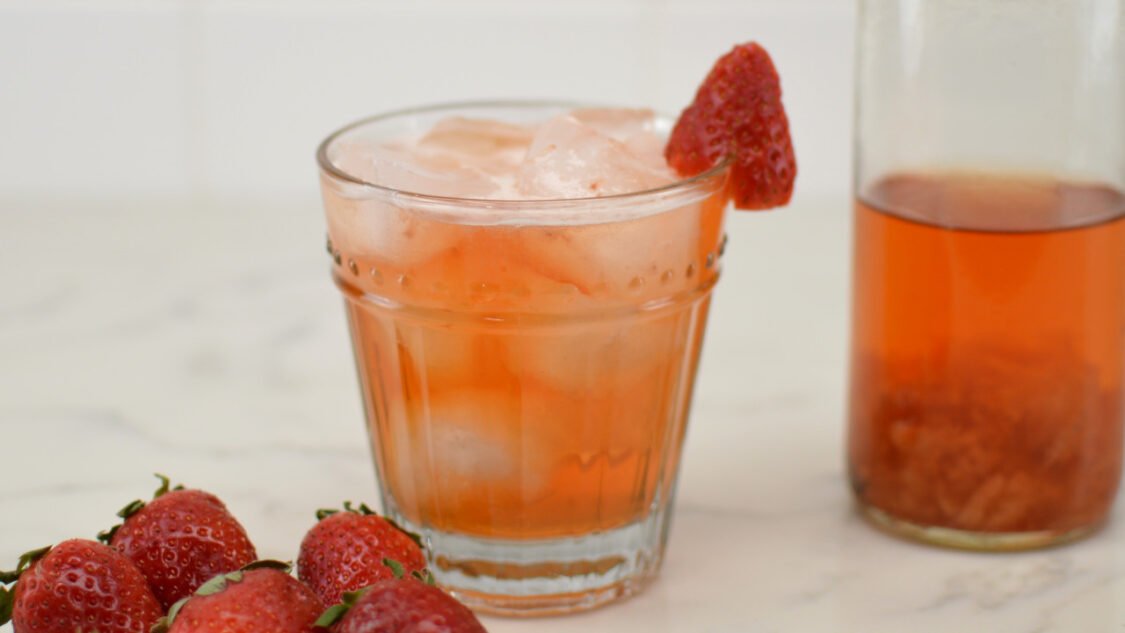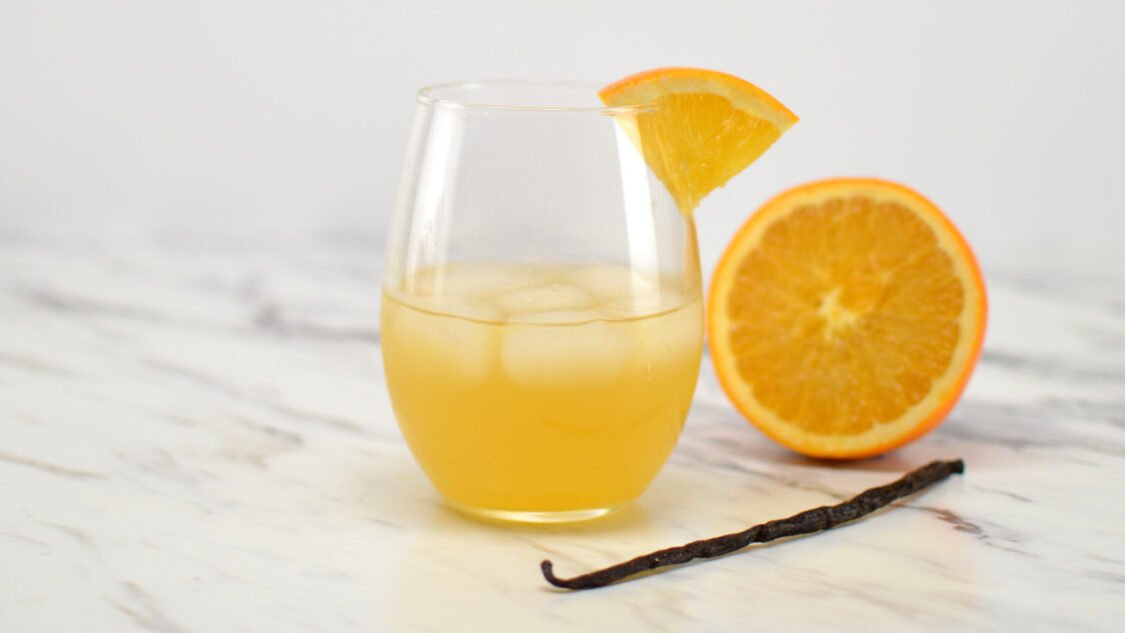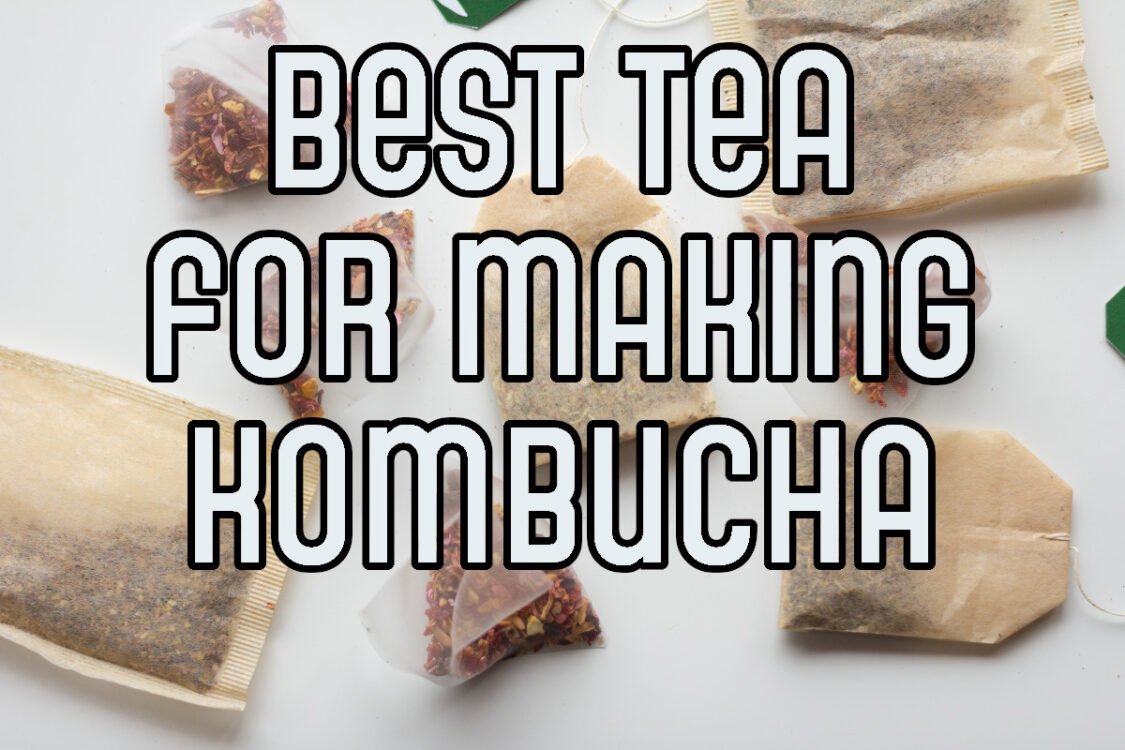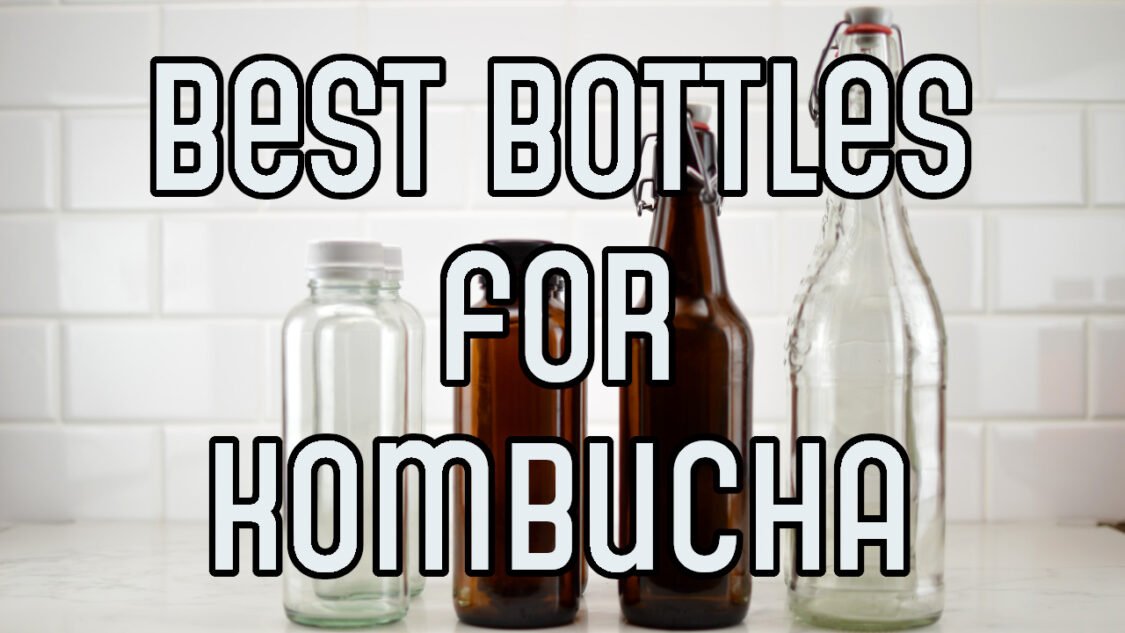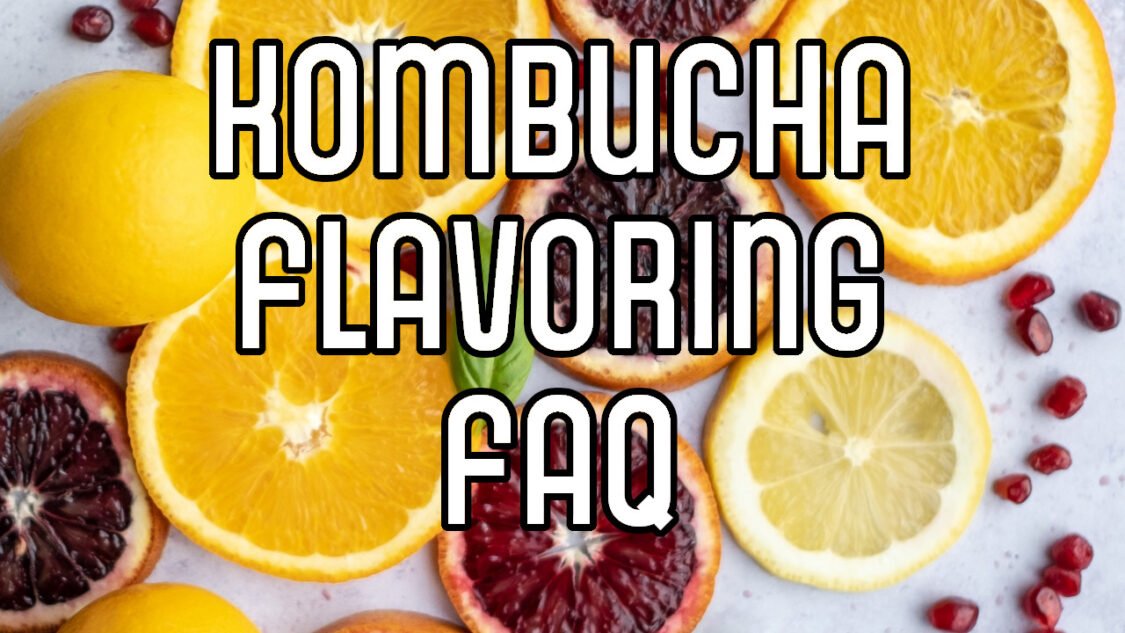Mint Chocolate Chip Kombucha
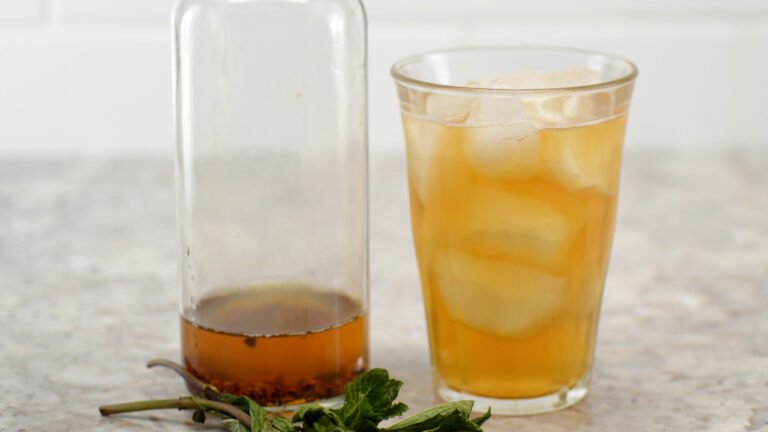
Mint chocolate chip kombucha made with 50% black tea and 50% green tea is a fusion of two popular tea varieties, offering a unique combination of flavors and health benefits. This can be a combination from separate batches of green and black tea kombuchas if you have multiple fermenters or you can make a batch just for this recipe and use 1/2 green and 1/2 black tea bags for the sweet tea of the primary fermentation of your kombucha. See step 2 of how to make kombucha.
The addition of vanilla syrup adds a sweet and creamy flavor to the drink, while the dark chocolate chips bring a rich and indulgent chocolatey taste. The fresh mint leaves added at bottling give the kombucha a cool and refreshing touch, making it a perfect drink for a warm day. The dark chocolate and vanilla flavors blend well with the tangy and slightly sweet taste of the kombucha, creating a delicious and sophisticated drink.

Kombucha Fermentation Overview
There are two fermentation phases when making kombucha:
Primary Fermentation: This is when you transform sweet tea into tart and tasty kombucha. Get all the details at my article on how to make kombucha.
Secondary Fermentation: This is when you carbonate your homemade kombucha by adding flavors (like mint and chocolate) and sugars and bottling it.
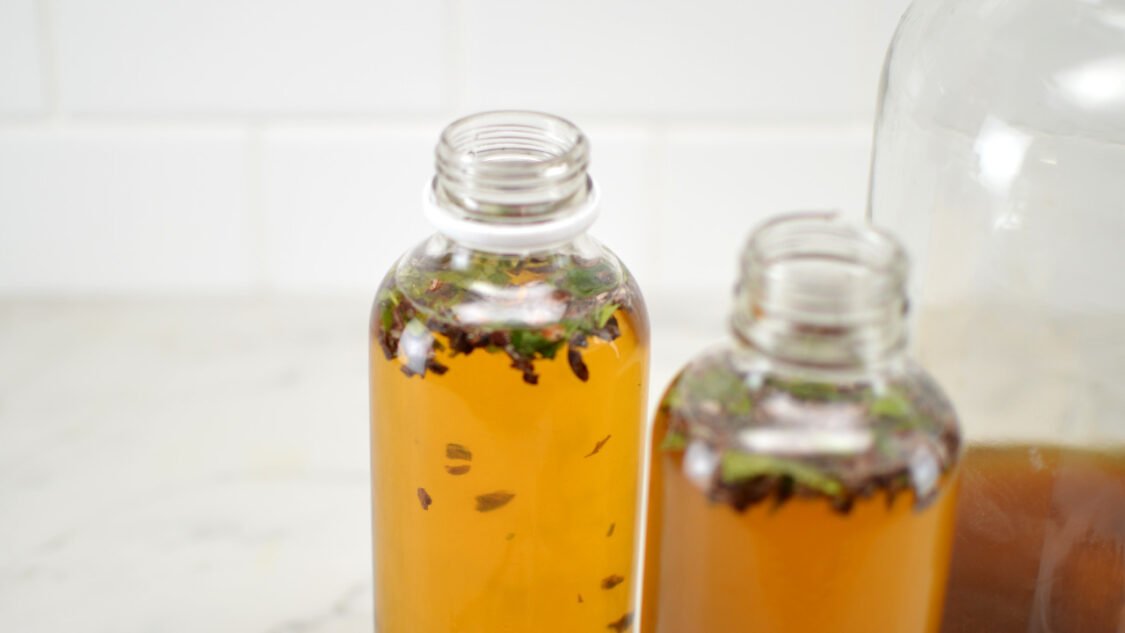
Preparing for Secondary Fermentation
This recipe makes about 7 x 16 fluid ounce bottles of finished kombucha (from a 1-gallon batch of unflavored homemade kombucha aka from your primary fermentation).
Reserve 2 cups (about 16 oz / 0.47L) kombucha and your SCOBY from your completed primary fermentation and set aside – you will use this as your starter for your next gallon batch of kombucha.
With your kombucha starter tea and SCOBY placed aside, you now have enough kombucha left to flavor and fill your bottles. This guide assumes are using 16 oz. glass bottles which are a popular choice for kombucha; however, there are many options for bottling kombucha.
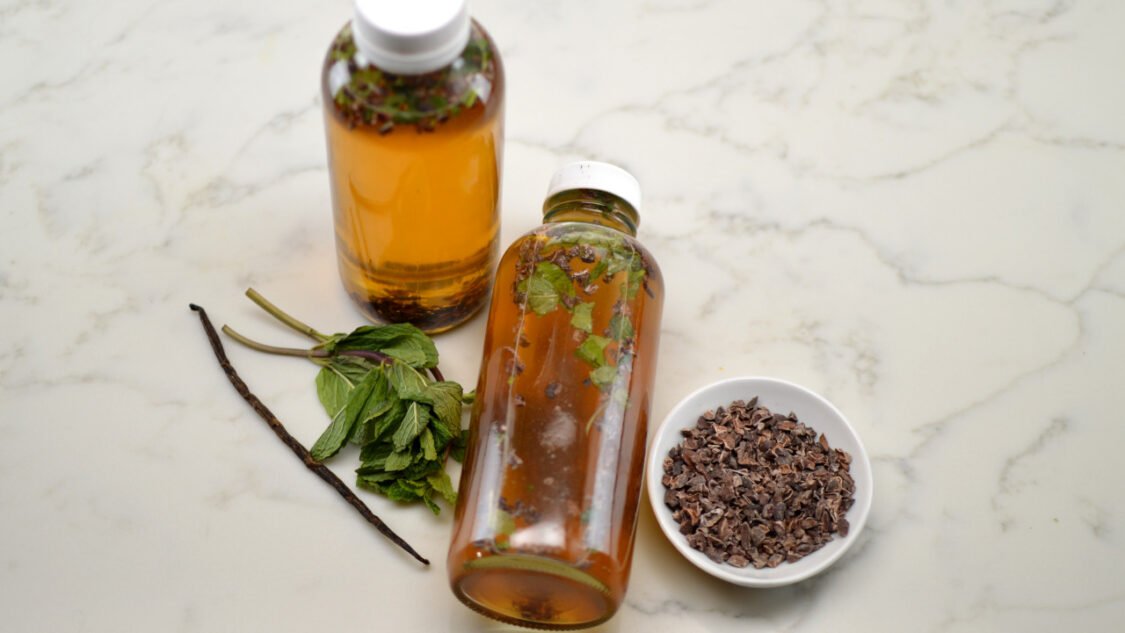
Ingredients to make Mint Chocolate Chip Kombucha
Kombucha Finished kombucha from your first fermentation is the base to which you will add the mint, vanilla and chocolate flavors
Black tea: Black tea is a type of tea that is fully fermented, resulting in a strong and robust flavor profile. During curing, black tea leaves are allowed to fully oxidize and turn black, which intensifies their flavor and aroma. The oxidation process also contributes to the development of tannins, which gives black tea its characteristic astringency and bitterness.
Green tea: Green tea is a type of tea that is made from the leaves of the Camellia sinensis plant. Unlike black tea, which is fully fermented, green tea leaves are minimally processed and not allowed to oxidize, preserving their natural green color and delicate flavor profile.
Green tea is known for its light, grassy, and slightly bitter taste, as well as its high levels of antioxidants, especially the polyphenol known as epigallocatechin gallate (EGCG). These antioxidants have been linked to a variety of potential health benefits, including reducing the risk of heart disease, certain types of cancer, and type 2 diabetes.
Cacao nibs: Cacao nibs are small pieces of crushed cacao beans (also called cocoa beans) with a bitter, chocolatey flavor. You can find them at most homebrewing shops and online (affiliate link ↗).
Fresh mint: Mint has a subtly sweet taste and cool sensation that comes from the menthol contained in the herb. The menthol sends a message to the brain that it’s consuming something cold, triggering a chilly sensation that simulates the effect that the herb is cooling the mouth. Spearmint is the most commonly used variety for cocktail and other beverages and has a subtler, lighter flavor, vaguely sweet flavor
Vanilla: There are several types of vanilla, typically named for where they are grown. Each type of vanilla bean has a very unique flavor.
Madagascar is the most popular type and Indian is a consistent favorite. Each type is slightly different:
Madagascar Vanilla – rich and creamy. The most popular vanilla and most widely available
Mexican Vanilla – bold, dark, smoky notes.
Indian Vanilla – full bodied, chocolate notes. One of the favorites among vanilla lovers.
Indonesian Vanilla – mild, well balanced. A good choice for kombucha.
Tahitian Vanilla – floral, notes of cherries and chocolate.
Here is a comprehensive article all about vanilla
Sugar: A touch of additional sugar for bacteria and yeast to feed on which creates carbonation–extra fizzy goodness. When filling 16 ounce bottles I’ve found a sugar cube has the right amount of sugar (1 tsp) for carbonation and is a convenient way to add the right amount without the mess.
How to make Mint Chocolate Chip Kombucha
Add Flavors: Divide cacao nibs, mint, vanilla and sugar between the bottles.
Bottle: Transfer kombucha to fermentation bottles.
Condition: For 3 to 10 days, until it reaches the carbonation level you like.
Enjoy: Chill in the fridge before serving and strain out fruit pieces when pouring (optional)
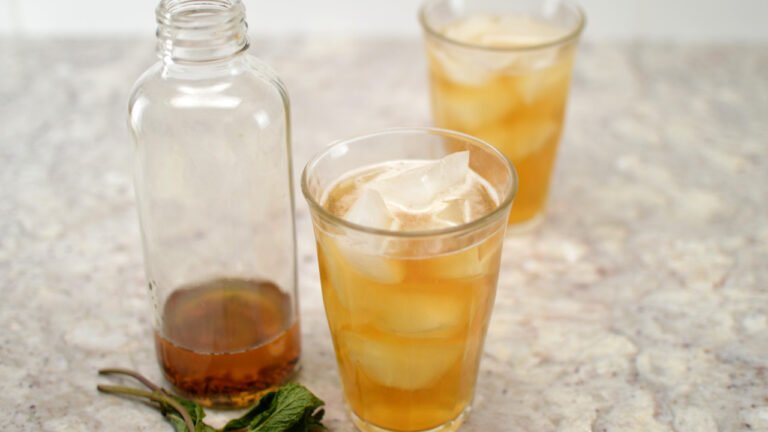
Mint Chocolate Chip Kombucha Recipe
Yield: 7 bottles • Active time: 20 minutes • Total time: 3 -10 days

This recipe assumes you are doing a secondary fermentation (flavoring and carbonation) in the bottle. You may also incorporate a third fermentation using the same proportions but following the third fermentation steps.
Ingredients:
1 gallon homemade kombucha from a first fermentation, 3.7 L – made with 1/2 green and 1/2 black tea or a combination from separate batches of green and black tea kombuchas if you have multiple fermenters
1/2 cup cacao nibs
1/2 cup fresh mint leaves
2 tsp pure vanilla extract or 1 whole vanilla bean
7 sugar cubes or 2 Tbs sugar 12 g
Instructions:
Make Kombucha: If you haven’t already, make a 1 gallon batch of kombucha using 50% black tea (4 bags or 4 tsp) and 50% green tea(4 bags or 4 tsp) and let it ferment until ready for flavoring. For details see step 2 of how to make kombucha.
Flavor: Evenly divide cacao, mint leaves and vanilla between the bottles. (Approximately 1 Tbs cacao, 1 Tbs mint leaves and 1/4 tsp vanilla per bottle)
Sweeten: Add one sugar cube per 16 bottle or evenly divide sugar between bottles (about 1 tsp per 16 0z bottle)
Bottle: Transfer kombucha into fermentation bottles, leaving about 1 inch empty at the top. Seal tightly.
Ferment: Place in a dark, room temperature area for 3 to 10 days, until it reaches the carbonation level you like. This process will go faster in warmer climates, and slower in cooler climates.
Enjoy: Chill your Mint chocolate chip kombucha bottles in the refrigerator before serving and strain the kombucha to remove cacao and mint pieces when serving (optional).
Homemade kombucha can be stored in the fridge, tightly sealed, for several weeks
Tips & Tricks:
Make sweet tea for your next batch the night before you flavor and bottling and let it cool on the stove overnight so that you can flavor your kombucha and get your next batch started at the same time.
If this is your first time brewing, it may be helpful to use a plastic water bottle as a gauge. Fill a recyclable plastic bottle with kombucha (leaving 1.5 inches empty at the top). When this bottle becomes rock hard, you’ll know the glass bottles are also ready. This will help you gauge how long it take for kombucha to carbonate your climate and will prevent bottle explosions.
Nutrition Information:
Kombucha Recipes You Might Also Like
More Kombucha Knowledge
Helping you learn to brew kombucha, find inspiration for new kombucha flavors and use kombucha to make kombucha mocktails

